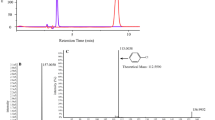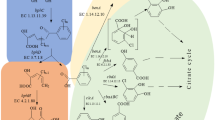Abstract
As there are at least three types of bacteria involved in the aerobic mineralization of polychlorinated biphenyls (PCBs), this study was undertaken to determine what catabolic features are lacking in biphenyl-degraders and to determine if chlorobenzoate- and chloroacetate-utilizing bacteria are as indigenous to soil as biphenyl-degraders. Bacteria were tested for their ability to utilize chlorinated acids and to cometabolize Aroclor 1254 and dibenzo-p-dioxane (dioxin). The broad and variable substrate specificity of the biphenyl dioxygenase among strains was noted by the range of <1 to 53% cometabolism of total PCB congeners and by the oxidation of dioxin, which was not a growth substrate. Growth on chloroalkanoic acids was more frequent with 2-chloropropionate (87% of all strains), 3-chloropropionate (72%), 4-chlorobutyrate (66%), and less frequent (28%) withtrans-3-chlorocrotonate. However, only one strain,Pseudomonas fluorescens K3, could utilize chloroacetate. No biphenyl-utilizers grew on 2- or 4-chlorobenzoate, and only five strains grew on 3-chlorobenzoate. Acetate and benzoate-utilizers were found in all three soils tested at levels near 106/g, whereas chloroacetate- or chlorobenzoate-utilizers were not detected. The inability of biphenyl-degraders to dehalogenate the products of PCB cometabolism is clearly unrelated to metabolism of saturated chloroaliphatic acids, with the notable exception of chloroacetate, since most strains grew on them. Thus, the inability to utilize chloroacetate, a central intermediate in the meta fission pathway, may be relevant to the incomplete catabolism of PCBs by biphenyl-utilizers.
Similar content being viewed by others
References
Adams RH, Huang CM, Higson FK, Brenner V & Focht DD (1992) Construction of a 3-chlorobiphenyl-utilizing recombinant from an intergeneric mating. Appl. Environ. Microbiol. 58: 647–654
Adriaens P, Huang C-M & Focht DD (1991) Biodegradation of PCBs by aerobic microorganisms. In: Baker RA (Ed) Organic substances and sediments in water (pp 311–326). Lewis Publishers, Chelsea, MI
Adriaens P, Kohler HP, Kohler-Staub D & Focht DD (1989) Bacterial dehalogenation of chlorobenzoates and coculture biodegradation of 4,4′-dichlorobiphenyl. Appl. Environ. Microbiol. 55: 887–892
Bedart DL, Unterman R, Bopp LH, Brennan MJ, Haberl ML & Johnson C (1986) Rapid assay for screening and characterizing microorganisms for the ability to degrade polychlorinated biphenyls. Appl. Environ. Microbiol. 51: 761–768
Bedard DL, Wagner RE, Brennan MJ, Haberl ML & Brown Jr JF (1987) Extensive degradation of Aroclors and environmentally transformed polychlorinated biphenyls byAlcaligenes eutrophus H850. Appl. Environ. Microbiol. 53: 1094–1102
Brenner V, Arensdorf JJ & Focht DD (1994) Genetic construction of PCB degraders. Biodegradation (in press)
Bopp LH (1986) Degradation of highly chlorinated PCBs byPseudomonas strain LB400. J. Ind. Microbiol. 1: 23–29
Dorn E, Hellwig M, Reineke W & Knackmuss H-J (1974) Isolation and characterization of a 3-chlorobezoate degrading pseudomonad. Arch. Microbiol. 99: 61–70
Focht DD & Brunner W (1985) Kinetics of biphenyl and polychlorinated biphenyl metabolism in soil. Appl. Environ. Microbiol. 50: 1058–1063
Focht DD & Shelton D (1987) Growth kinetics ofPseudomonas alcaligenes C-O relative to inoculation and 3-chlorobenzoate metabolism in soil. Appl. Environ. Microbiol. 53: 1846–1849
Fulthorpe RR & Wyndham RC (1991) Transfer and expression of the catabolic plasmid pBRC60 in wild bacterial recipients in a feshwater ecosystem. Appl. Environ. Microbiol. 57: 1546–1553
Furukawa K & Chakrabarty AM (1982) Involvement of plasmids in total degradation of chlorinated biphenyls. Appl. Environ. Microbiol. 44: 619–626
Furukawa K, Matsumura F & Tonomura K (1978)Alcaligenes andAcinobacter strains capable of degrading polychlorinated biphenyls. Agric. Biol. Chem. 42: 543–548
Goldman P, Milne GWA & Keister DB (1968) Carbon-halogen bond cleavage. III. Studies of bacterial halidohydrolases. J. Biol. Chem. 243: 428–434
Hardman DJ & Slater JH (1981) The dehalogenase complement of a soil pseudomonad grown in closed and open cultures on haloalkanoic acids. J. Gen. Microbiol. 127: 399–405
—— (1981) Dehalogenases in soil bacteria. J. Gen. Microbiol. 123: 117–128
Havel J & Reineke W (1991) Total degradation of various chlorobiphenyls by cocultures and in vivo constructed hybrid pseudomonads. FEMS Microbiol. Lett. 78: 163–170
Hernandez BS, Higson FK, Kondrat R & Focht DD (1991) Metabolism of and inhibition by chlorobenzoates inPseudomonas putida P111. Appl. Environ. Microbiol. 57: 3361–3366
Hickey WJ, Brenner V & Focht DD (1992) Mineralization of 2-chloro- and 2,5-dichlorobiphenyl byPseudomonas sp. strain UCR2. FEMS Microbiol. Lett. 98: 175–180
Hickey WJ & Focht DD (1990) Degradation of mono-, di-, and trihalogenated benzoic acids byPseudomonas aeruginosa JB2. Appl. Environ. Microbiol. 56: 3842–3850
Hickey WJ, Seales DB & Focht DD (1993) Enhanced mineralization of polychlorinated biphenyls in soil inoculated with chlorobenzoate-degrading bacteria. Appl. Environ. Microbiol. 59: 1194–1200
Higson FK & Focht DD (1992) Utilization of 3-chloro 2-methylbenzoic acid byPseudomonas cepacia MB2 through the meta fission pathway. Appl. Environ. Microbiol. 58: 2501–2504
Jensen HL (1963) Carbon nutrition of some microorganisms decomposing halogen-substituted aliphatic acids. Acta Agricultura Scandinavica 13: 404–412
Kawasaki H, Tone N & Tonomura K (1981) Plasmid-determined dehalogenation of haloacetates inMoraxella species. Agric. Biol. Chem. 45: 29–34
—— (1981) Purification and properties of haloacetate halidohydrolase specified by plasmid fromMoraxella sp. strain B. Agric. Biol. Chem. 45: 35–42
Knackmuss H-J (1984) Biochemistry and practical implications of organohalide degradation. In: Klug MJ & Reddy CA (Eds) Current perspectives in microbial ecology (pp 687–693). American Society for Microbiology, Washington, DC
Kohler H-PE, Kohler-Staub D & Focht DD (1988) Cometabolism of PCBs: enhanced transformation of Arocolor 1254 by growing bacterial cells. Appl. Environ. Microbiol. 54: 1940–1945
Kuhm AE, Stolz A & Knackmuss H-J (1991) Metabolism of naphthalene by the biphenyl-degrading bacteriumPseudomonas paucimobilis Q1. Biodegradation 2: 115–120
Marks TS, Smith ARW & Quirk AV (1984) Degradation of 4-chlorobenzoic acid byArthrobacter sp. Appl. Environ. Microbiol. 48: 1020–1025
McCullar MV, Brenner V, Adams RH & Focht DD (1994) Construction of a novel PCB-degrading bacterium: utilization of 3,4′-dichlorobiphenyl byPseudomonas acidovorans. Appl. Environ. Microbiol. (in press) Mokross H, Schmidt E & Reineke W (1990) Degradation of 3-chlorobiphenyl by in vivo constructed hybrid pseudomonads. FEMS Microbiol. Lett. 71: 179–185
Pertsova RN, Kunc F & Golovleva LA (1984) Degradation of 3-chlorobenzoate in soil by pseudomonads carrying biodegradative plasmids. Folia Microbiol. 29: 242–247
Pettigrew CA, Breen A, Corcoran C & Sayler GS (1990) Chlorinated biphenyl mineralization by individual populations and consortia of freshwater bacteria. Appl. Environ. Microbiol. 56: 2036–2045
Starr MP, Stolp H, Trüper HG, Balows A & Schlegel HG (1981) The prokaryotes. Springer-Verlag, New York
Stucki G, Brunner W, Staub D & Leisinger T (1981) Microbial degradation of chlorinated C1 and C2 hydrocarbons. In: Leisinger T, Cook AM, Hütter R & Nüesch J (Eds) Microbial degradation of xenobiotic and recalcitrant compounds (pp 131–137). Academic Press, New York
Timmis KN, Lehrbach PR, Harayama S, Don RH, Mermod N, Bas S, Leppik R, Weightman AJ, Reineke W & Knackmuss H-J (1985) Analysis and manipulation of plasmid-coded pathways of the catabolism of aromatic compounds by soil bacteria. In: Helinski DR, Cohen SN, Clewell DB, Jackson DA & Hollaender A (Eds) Plasmids in bacteria (pp 719–739). Plenum Publishing, New York
Walia S, Khan A & Rosenthal N (1990) Construction and applications of DNA probes for detection of polychlorinated biphenyl-degrading genotypes in toxic organic-contaminated soil environments. Appl. Environ. Microbiol. 56: 254–259
Author information
Authors and Affiliations
Rights and permissions
About this article
Cite this article
Hernandez, B.S., Arensdorf, J.J. & Focht, D.D. Catabolic characteristics of biphenyl-utilizing isolates which cometabolize PCBs. Biodegradation 6, 75–82 (1995). https://doi.org/10.1007/BF00702302
Accepted:
Issue Date:
DOI: https://doi.org/10.1007/BF00702302




